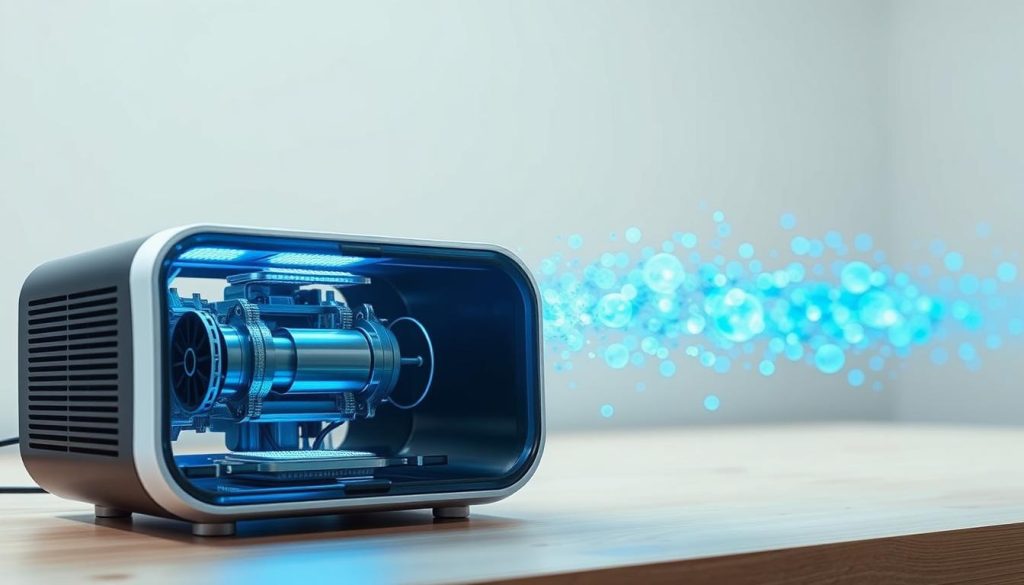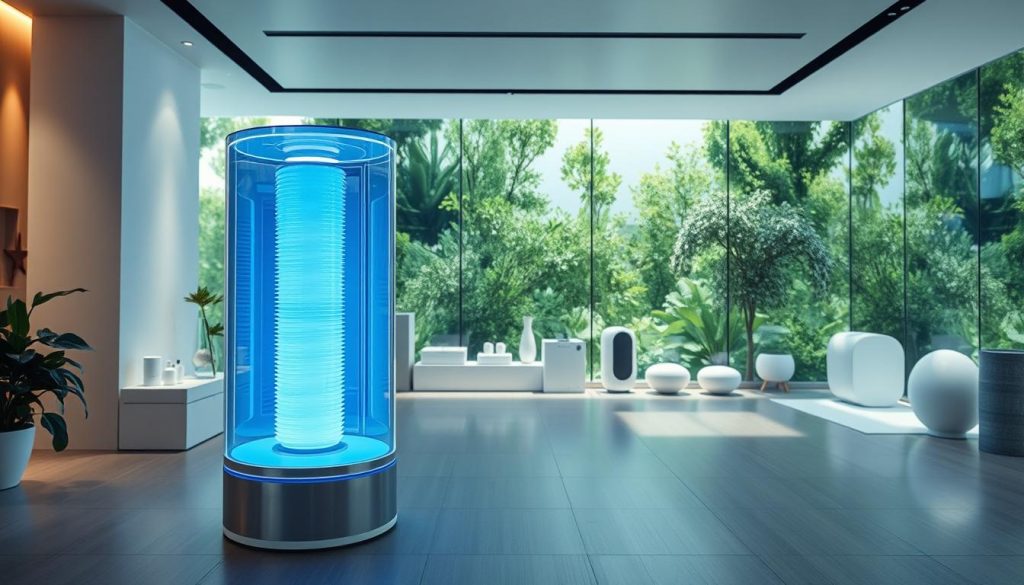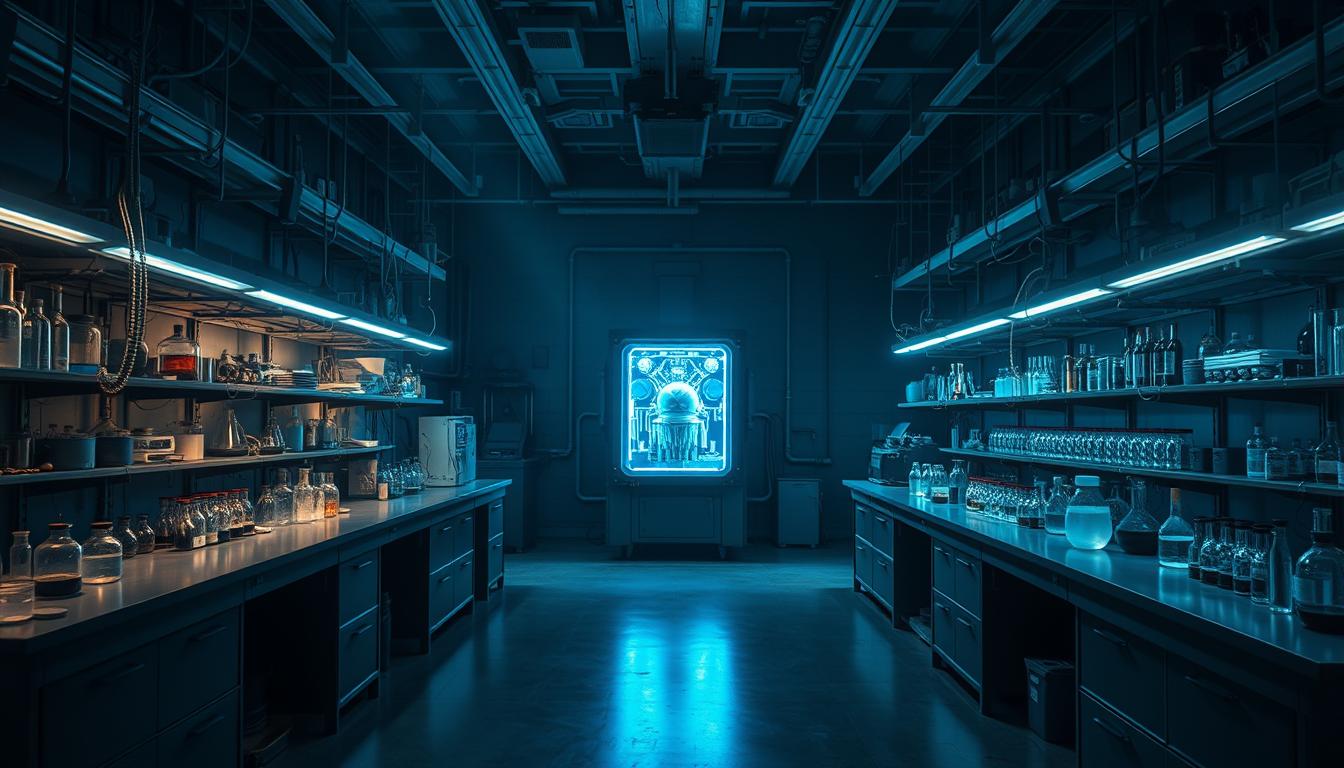Negative ions have caught the eye of many, sparking a debate that needs a closer look. Do they really help our health, or is it just a myth? This article dives into the controversy, looking at the science and health claims around negative ions.
For those who care about their health, knowing the truth about negative ions is key. It helps us make smart choices and avoid getting lost in wellness trends.
We’ll look at the research on negative ions, comparing the exciting findings with the doubts. Let’s uncover if negative ions are backed by science or just a fad.
What are Negative Ions?
Negative ions are atoms or molecules with an extra electron, giving them a negative charge. This happens naturally through the ionization process. Energy from the environment, like sunlight or moving water, causes electrons to detach and bond with others.
Definition and Characteristics
Negative ions attract pollutants, allergens, and airborne particles. They neutralize them by binding. This negative ionization is seen as beneficial, improving air quality and well-being. They are small, highly reactive, and create a fresh, clean atmosphere.
Common Sources
Negative ions are plentiful in nature. Powerful natural ion producers include lightning, moving water, and sunlight. Indoors, devices like commercial ionizers can create these ions artificially.
- Lightning during thunderstorms
- Waterfalls
- Ocean waves
- Sunlight
- Commercial ionizers
The Science Behind Negative Ions
Negative ions are more than just stories. They are backed by ion research and air ionization science. This part looks into the big steps in negative ion studies. It follows the history and the latest science.
Nobel Prize Research and Discoveries
The study of ions got a big boost with Nobel Prizes. Marie Curie won for her work on radioactivity. Her findings helped us understand ion research better, showing ions in nature and their benefits.
Robert Millikan also won a Nobel Prize for his work on electron charge. His work helped us grasp air ionization science better. These discoveries have changed how we study negative ions today.
Modern Studies and Findings
Recently, negative ion studies have grown a lot. Scientists use new methods to show how negative ions work in real life. The University of California found health benefits from better air quality and brain function with negative ions.
World-renowned labs and think tanks have also confirmed negative ions’ benefits. They show how these ions can make indoor spaces better. Today’s research keeps adding to what we know about negative ions, making our lives better.
Are Negative Ions Pseudoscience?
The debate over ionization has grown in the scientific world. Some say negative ions have many health benefits. But, the scientific look into ions shows mixed results, calling for a deeper dive.
Critics say there’s not enough proof to back the claims of ionizer supporters. They think these claims are not based on solid science.
It’s important to tell real science from fake. Scientists want to see controlled studies and results that can be repeated. But, so far, the evidence is not clear, making many skeptical.
People often share stories of how ionizers helped them. But, these stories need careful study to be trusted. The debate shows we need more research to know if negative ions really help or if it’s just a myth.
Health Benefits Claimed by Negative Ion Supporters
Supporters of negative ion therapy talk about many health benefits. They say it improves air quality, boosts mood, and helps with allergies and asthma. These points make a strong case for the health benefits of ionization.
Improved Air Quality
One big claim is that negative ion therapy cleans the air. It’s thought that negative ions grab onto dust, pollen, and smoke, making them too heavy to fly. This could mean cleaner, fresher air inside, which is great for closed spaces.

Enhancement of Mood and Energy
Another benefit is better mood and energy. Studies show that negative ions can increase serotonin, a mood booster. This can make you feel happier and more energetic, helping to fight stress and tiredness.
Relief for Allergies and Asthma
Supporters also say it helps with allergies and asthma. By removing airborne allergens, it can lessen symptoms. This is good news for those with breathing problems, as it means easier breathing and a more comfortable home.
Criticism and Skepticism of Negative Ions
Some people believe negative ions can be good for health. But, many scientists are not convinced. They question the proof and how these studies were done.
Lack of Consensus in Scientific Community
Scientists agree that negative ions might help a bit. But, they say the evidence is not strong enough. Critics point out that many studies are small or don’t control for other factors. This makes it hard to find solid proof of their health benefits.
Placebo Effect and Confirmation Bias
Another issue is the placebo effect. People might feel better because they think the ions are working, not because they actually are. Also, people might notice improvements because they expect to. This makes it hard to know what’s real and what’s just in their heads.
| Aspect | Supporters’ View | Critics’ View |
|---|---|---|
| Empirical Evidence | Positive effects on mood and air quality | Lack of rigorous, large-scale studies |
| Scientific Consensus | Some supportive studies | Insufficient for broad health claims |
| Placebo Effect | Rarely acknowledged | Potential significant contributor to perceived benefits |
| Confirmation Bias | Not considered | Must be accounted for in studies |
Negative Ion Generators: Do They Work?
Many wonder if negative ion generators really work as promised. These devices aim to release negative ions, which could improve air quality and health. But what does science say about these claims?
Studies on negative ionizers show mixed results. Some research says they can catch pollutants, making the air cleaner. People using ionic air purifiers often say they feel the air is fresher and their allergies improve.

But, some doubt the science behind these benefits. While some places see big improvements, the impact varies a lot. It depends on the device, the space, and the pollutants. So, while the idea of ion generator science is interesting, its practical use needs more proof.
For those thinking about getting an ionic air purifier, it’s important to look at both science and personal experiences. As more studies come out, we’ll learn more about how well negative ion generators work. This will help people make better choices.
Comparing Negative Ions to Other Air Purification Methods
Many air purification technologies are available to improve indoor air quality. Each method has its own strengths and weaknesses. This includes negative ion generators, HEPA filters, and activated carbon filters.
HEPA Filters
HEPA filters can catch up to 99.97% of particles as small as 0.3 microns. They are great at removing dust, pollen, and allergens. This makes them a top choice for people with allergies.
HEPA filters are different from ionizers. They focus on filtering particles without changing the air’s ion levels.
Activated Carbon Filters
Activated carbon filters are good at removing gases, odors, and VOCs. They use activated carbon to adsorb air impurities. This makes them a good match for ionizers, which are better at neutralizing particles.
UV Light Purifiers
UV light purifiers kill bacteria, viruses, and other microorganisms with ultraviolet radiation. They work differently than ionizers and filters. UV light purifiers are often used with other systems to boost their effectiveness.
These purifiers focus on killing microbes, unlike filters that remove particles.
Real-World Examples of Negative Ion Use
Negative ions are becoming more popular in many areas, like the wellness industry and commercial spaces. Here are some examples of how these ions are used in different places.
Spa and Wellness Centers
Spas and wellness centers use negative ions to make their clients’ experiences better. They put commercial ionizers in relaxation areas and treatment rooms. This improves the air and makes people feel better.
By using ionization technology, these places attract people who want to be healthy. They offer wellness benefits that are backed by science.
Home and Office Ionizers
More people are using ionizers at home and in offices to make their spaces better. They use commercial ionizers to get rid of allergens and pollutants. This makes the air healthier.
As people learn more about wellness and ionization, they buy these technologies. They want to improve their daily lives.

- Inclusion of ionizers in major spa chains like the Four Seasons and Marriott’s Westin Hotels.
- Integration of negative ion technology in popular wellness retreats, such as Canyon Ranch and Miraval Resorts.
- Implementation of ionization systems in corporate offices like those of Google and Apple to boost employee wellness.
| Application | Location | Benefits |
|---|---|---|
| Spa and Wellness Centers | Four Seasons, Canyon Ranch | Enhanced relaxation and air quality |
| Home Ionizers | Residential settings | Allergen reduction, improved air quality |
| Office Ionizers | Google, Apple | Better employee health and productivity |
Legal and Regulatory Status of Negative Ion Products
In the United States, the rules for ion products are strict. The Environmental Protection Agency (EPA) and the Food and Drug Administration (FDA) check these products closely. They make sure they meet safety and marketing standards.
It’s key to know the rules for ion products. The FDA checks health claims to see if they’re true. Marketing must be honest and not trick people.
States also have their own rules for ion products. Following these rules is important for success. This way, products are safe and honest, keeping trust in the industry.
But, the rules don’t just stop at the U.S. Companies selling ionizers abroad must follow different laws. This shows how important it is to know the laws in many places for selling ion products worldwide.
Public Perception vs. Scientific Evidence
Negative ions have caught a lot of attention, but there’s a big gap between what people think and what science says. This part looks at how media and customer stories compare to real studies.
Media Hype vs. Reality
Media loves to talk about the health perks of negative ions, making it sound exciting. They share stories of better sleep, clearer minds, and improved health from using ionizers. But, when we check these claims against science, the truth is often different.
For instance, some studies say negative ions might slightly improve air or mood. But big, trusted research usually finds the benefits aren’t as big as the media says. This makes people either believe in the benefits or doubt them, depending on what they’ve heard.
Consumer Experiences and Testimonials
People who use ionizers share their stories, saying they’ve noticed better air and health. They talk about fewer allergy symptoms, better moods, and feeling cleaner air.
But, science tells a more careful story. While personal stories are important, they can also be influenced by how we think or feel. So, it’s key to look at both what people say and what science finds to understand if ionizers really work.
Final Thoughts: Negative Ions, Pseudoscience or Proven Science?
The debate on negative ions is ongoing. We’ve looked at many views on negative ions, from their supposed health benefits to the doubts raised. Each part of this article has given us important information about this topic.
Some people believe negative ions can make the air better, improve mood, and help with allergies and asthma. But, the lack of agreement among scientists and the role of the placebo effect mean we should be careful. Devices like negative ion generators and home ionizers are popular in spas and wellness centers. Yet, the myths about their effectiveness are still a big issue.
To sum up, while some studies and experiences suggest negative ions have benefits, the debate is still alive. It’s important for us to look at the science and not just what we hear. This way, we can make informed choices, separating fact from fiction.

